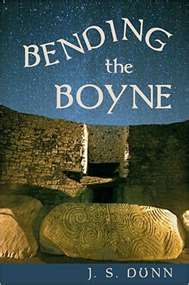Embrace Winter Solstice and the Reborn Sun by Author J.S. Dunn
About J.S. Dunn
J.S. Dunn resided in Ireland during the past decade, and from there pursued early Bronze Age culture along the Atlantic coasts of Spain, France, Wales, and Ireland. In 2006, the author attended the Dover Boat symposium (UK) regarding the earliest known Atlantic plank boat. The research for BENDING THE BOYNE yielded many friends in diverse fields including archaeology, geology, and Bronze Age tool-making.
This is a debut novel and won the 2011 Next Generation Indie Award for historical fiction.
Find out more about the author visit http://www.jsdunnbooks.com or on Facebook athttp://www.facebook.com/pages/Bending-The-Boyne/192198197473429
Embrace Winter Solstice And The Reborn Sun
Find your inner astronomer at Europe's largest passage mounds. The Boyne mounds in Ireland are older than the Pyramids, and Stonehenge. In our era almost five thousand years later, winter solstice sunrise still penetrates into the central mound of Newgrange and lights the inner chamber.
For around ten sunrises in December, sunlight penetrates 60-plus feet into the central chamber, washing the carved stones in golden light. If you visit the Boyne, with over 200,000 annual visitors, you can view the solstice event enacted. It's an incredible sensation to stand inside the great mound in utter dark while light creeps the long passage then bursts in dazzling and filling the inner chamber. (To experience the actual solstice sunrise one must enter a lottery, booked several years ahead.)
Solstice occurs when the earth tilts at a maximum away from the sun, for those in the northern hemisphere. There is little reason to depict the ancients viewing this with fear; in fact, over the millennia many cultures carefully charted solstice. At the Boyne then and now, the people watch with awe when the great mound functions as intended, showing the reborn sun that will bring spring's bounty.
The Boyne astronomy culture had the action, it was the power center for the north Atlantic. Each mound had specific duties in the solar calendar. How did these great mounds fall into disuse? No doubt the ancient solstice light show led to the myth that these mounds contained hidden gold. Bending The Boyne uses the latest concepts about the ancient Gaels (later called Celts by Greeks and Romans) in a tale of greed and gold when marauders arrive at the Boyne around 2200 BC.
Boann, the female protagonist, comes from the earliest Irish myths where she appears briefly in a tangled story that mentions the birth of her son Aengus. "...they made the sun stand still to the end of nine months / strange the tale..." Her son Aengus, born at winter solstice, symbolizes the astronomy practiced at the mounds. Confusion and a culture clash about his birth lead to tragedy.
Though modern "druids" gather here and at Stonehenge for the solstice, these megaliths were built thousands of years earlier and belong to a time before any mumbling druids or Iron Age "Celtic" beliefs and rituals... This is the birth of the Gaels and a Gaelic culture and language.
About Bending the Boyne
The great Boyne passage mounds are older than the Pyramids, and Stonehenge. Why were these great mounds abandoned around 2200 BCE?
2200 BCE: Changes rocking the Continent reach Eire with the dawning Bronze Age. Marauders invade the island seeking copper and gold and their long bronze knives challenge the peaceful native starwatchers. The young astronomer Boann and the enigmatic Cian need all their wits and courage to save their people and their great Boyne mounds. Tensions build on Eire between new and old cultures and between Boann, Elcmar, and her son Aengus, and eventually explode. What emerges from the rubble of battle are Ireland's oldest legends in a totally new light.
BENDING THE BOYNE uses the new paradigm that "Celtic" culture developed along the north Atlantic coasts (not in central Europe) and arose in the early Bronze Age. This story appeals to fans of the Bronze Age, ancient astronomy, and archaeology. The tale echoes with literary heroes: Swift, Yeats, Flann O'Brien, and many others.

